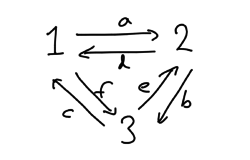Difference between revisions of "M(16,2,2)"
(Corrected Picard group) |
|||
| Line 29: | Line 29: | ||
\end{array}\right)</math> | \end{array}\right)</math> | ||
|O-morita-frob = 1 | |O-morita-frob = 1 | ||
| − | |Pic-O = <math>S_3</math><ref>Proposition 4.3 of [[References|[BKL18]]]</ref> | + | |Pic-O = <math>C_2 \times S_3</math><ref>Proposition 4.3 of [[References|[BKL18]]]</ref> |
|PIgroup = | |PIgroup = | ||
|source? = No | |source? = No | ||
Revision as of 13:21, 14 November 2018
| Representative: | [math]k((C_4 \times C_4):C_3)[/math] |
|---|---|
| Defect groups: | [math]C_4 \times C_4[/math] |
| Inertial quotients: | [math]C_3[/math] |
| [math]k(B)=[/math] | 8 |
| [math]l(B)=[/math] | 3 |
| [math]{\rm mf}_k(B)=[/math] | 1 |
| [math]{\rm Pic}_k(B)=[/math] | [math][/math] |
| Cartan matrix: | [math]\left( \begin{array}{ccc} 6 & 5 & 5 \\ 5 & 6 & 5 \\ 5 & 5 & 6 \\ \end{array} \right)[/math] |
| Defect group Morita invariant? | Yes |
| Inertial quotient Morita invariant? | Yes |
| [math]\mathcal{O}[/math]-Morita classes known? | Yes |
| [math]\mathcal{O}[/math]-Morita classes: | [math]\mathcal{O}((C_4 \times C_4):C_3)[/math] |
| Decomposition matrices: | [math]\left( \begin{array}{ccc} 1 & 0 & 0 \\ 0 & 1 & 0 \\ 0 & 0 & 1 \\ 1 & 1 & 1 \\ 1 & 1 & 1 \\ 1 & 1 & 1 \\ 1 & 1 & 1 \\ 1 & 1 & 1 \\ \end{array}\right)[/math] |
| [math]{\rm mf}_\mathcal{O}(B)=[/math] | 1 |
| [math]{\rm Pic}_{\mathcal{O}}(B)=[/math] | [math]C_2 \times S_3[/math][1] |
| [math]PI(B)=[/math] | |
| Source algebras known? | No |
| Source algebra reps: | |
| [math]k[/math]-derived equiv. classes known? | Yes |
| [math]k[/math]-derived equivalent to: | Forms its own derived equivalence class |
| [math]\mathcal{O}[/math]-derived equiv. classes known? | Yes |
| [math]p'[/math]-index covering blocks: | |
| [math]p'[/math]-index covered blocks: | M(16,2,1) |
| Index [math]p[/math] covering blocks: |
Contents
Basic algebra
Quiver: a:<1,2>, b:<2,3>, c:<3,1>, d:<2,1>, e:<3,2>, f:<1,3>
Relations w.r.t. [math]k[/math]: abca=bcab=cabc=0, dfed=fedf=edfe=0, ad=fc, be=da, cf=eb
Other notatable representatives
Projective indecomposable modules
Labelling the simple [math]B[/math]-modules by [math]1,2,3[/math], the projective indecomposable modules have Loewy structure as follows:
[math]\begin{array}{ccc} \begin{array}{c} 1 \\ 2 \ 3 \\ 3 \ 1 \ 2 \\ 1 \ 2 \ 3 \ 1 \\ 3 \ 1 \ 2 \\ 2 \ 3 \\ 1 \\ \end{array}, & \begin{array}{c} 2 \\ 1 \ 3 \\ 3 \ 2 \ 1 \\ 2 \ 1 \ 3 \ 2 \\ 3 \ 2 \ 1 \\ 1 \ 3 \\ 2 \\ \end{array}, & \begin{array}{c} 3 \\ 1 \ 2 \\ 2 \ 3 \ 1 \\ 3 \ 1 \ 2 \ 3 \\ 2 \ 3 \ 1 \\ 1 \ 2 \\ 2 \\ \end{array} \end{array} [/math]
Irreducible characters
All irreducible characters have height zero.
Back to [math]C_4 \times C_4[/math]
